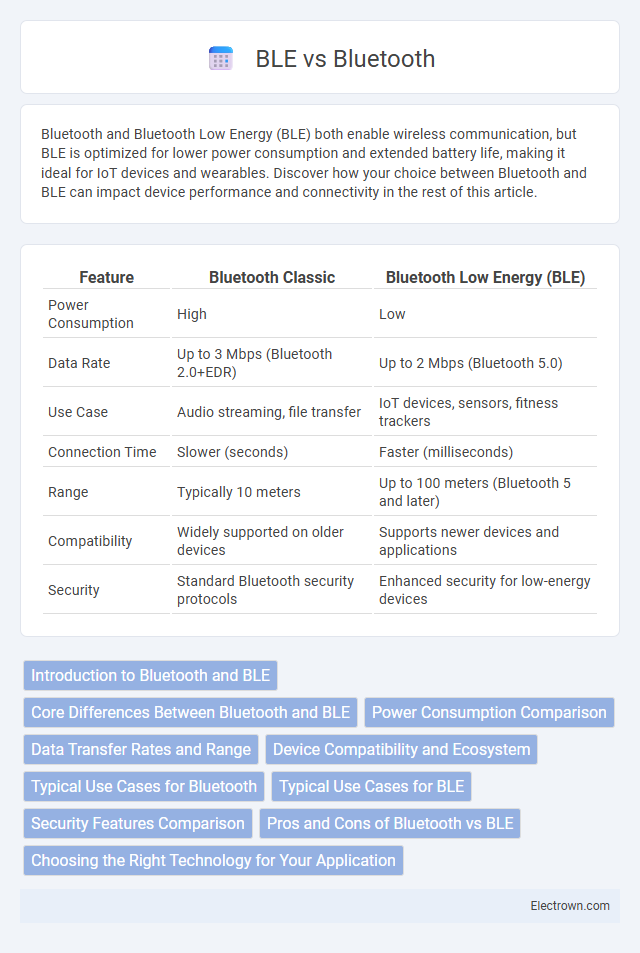Bluetooth and Bluetooth Low Energy (BLE) both enable wireless communication, but BLE is optimized for lower power consumption and extended battery life, making it ideal for IoT devices and wearables. Discover how your choice between Bluetooth and BLE can impact device performance and connectivity in the rest of this article.
Table of Comparison
| Feature | Bluetooth Classic | Bluetooth Low Energy (BLE) |
|---|---|---|
| Power Consumption | High | Low |
| Data Rate | Up to 3 Mbps (Bluetooth 2.0+EDR) | Up to 2 Mbps (Bluetooth 5.0) |
| Use Case | Audio streaming, file transfer | IoT devices, sensors, fitness trackers |
| Connection Time | Slower (seconds) | Faster (milliseconds) |
| Range | Typically 10 meters | Up to 100 meters (Bluetooth 5 and later) |
| Compatibility | Widely supported on older devices | Supports newer devices and applications |
| Security | Standard Bluetooth security protocols | Enhanced security for low-energy devices |
Introduction to Bluetooth and BLE
Bluetooth is a wireless communication technology designed for short-range data exchange between devices, supporting high data rates and continuous connections. Bluetooth Low Energy (BLE) is a specialized subset optimized for ultra-low power consumption, making it ideal for battery-powered devices such as wearables and IoT sensors. Your choice between Bluetooth and BLE depends on the balance between energy efficiency and data throughput required for your application.
Core Differences Between Bluetooth and BLE
Bluetooth operates primarily on continuous radio transmission for steady data exchange, while BLE (Bluetooth Low Energy) uses short bursts of radio waves to conserve power during intermittent data transfer. BLE is optimized for low power consumption and long battery life, making it ideal for IoT devices and fitness trackers, whereas classic Bluetooth supports higher data rates suited for audio streaming and larger data payloads. The two technologies share the same frequency band (2.4 GHz) but differ significantly in protocols, power efficiency, and use cases.
Power Consumption Comparison
Bluetooth Low Energy (BLE) consumes significantly less power than classic Bluetooth, making it ideal for devices requiring prolonged battery life. BLE achieves energy efficiency through shorter transmission intervals and reduced idle listening times. This power optimization enables wearable technology, smart home devices, and IoT sensors to operate for months or even years on a single battery charge.
Data Transfer Rates and Range
Bluetooth Classic supports higher data transfer rates up to 3 Mbps, making it suitable for audio streaming and large file transfers, whereas Bluetooth Low Energy (BLE) typically offers data rates around 1 Mbps, optimized for low power consumption and intermittent data transmission. The range of Bluetooth Classic generally spans up to 100 meters in ideal conditions, while BLE, designed for energy efficiency, usually operates effectively within 10 to 30 meters, depending on environmental factors. You should choose Bluetooth or BLE based on whether your priority is faster data transfer or extended battery life with moderate range.
Device Compatibility and Ecosystem
Bluetooth offers wide device compatibility across smartphones, laptops, and audio devices, supporting both classic Bluetooth and Bluetooth Low Energy (BLE) protocols. BLE is optimized for low power consumption and is prevalent in fitness trackers, smartwatches, and IoT devices, ensuring seamless integration within energy-efficient ecosystems. Your choice between Bluetooth and BLE should consider the compatibility needs and the specific ecosystem of devices you plan to connect.
Typical Use Cases for Bluetooth
Typical use cases for Bluetooth include wireless audio streaming, file transfer, and peripheral device connections such as keyboards, mice, and printers. Bluetooth enables seamless communication between smartphones, laptops, and wearables, supporting hands-free calling and audio playback. Your devices benefit from Bluetooth for short-range, high-bandwidth applications requiring stable connections and moderate power consumption.
Typical Use Cases for BLE
Bluetooth Low Energy (BLE) is optimized for battery-efficient, short-range communication in devices such as fitness trackers, smartwatches, and home automation systems. BLE enables seamless data exchange in applications requiring intermittent transmission, including health monitoring sensors and proximity-based asset tracking. Its low power consumption and reliable connectivity make it ideal for IoT devices and wearable technology.
Security Features Comparison
Bluetooth Classic employs robust security measures such as Secure Simple Pairing (SSP) with Elliptic Curve Diffie-Hellman (ECDH) key exchange to prevent eavesdropping and man-in-the-middle attacks. Bluetooth Low Energy (BLE) enhances security by integrating LE Secure Connections, which use stronger encryption algorithms and improved pairing mechanisms to resist passive and active attacks. BLE's approach also supports privacy features like address randomization, reducing tracking risks, making it more suitable for modern IoT applications requiring stringent security standards.
Pros and Cons of Bluetooth vs BLE
Classic Bluetooth offers higher data transfer rates and better compatibility with older devices but consumes more power, making it less ideal for battery-sensitive applications. Bluetooth Low Energy (BLE) excels in energy efficiency with extended battery life and faster connection times, though it supports lower data throughput and may face limitations in continuous streaming scenarios. Choosing between Bluetooth and BLE depends on the specific use case, balancing power consumption, data needs, and device compatibility.
Choosing the Right Technology for Your Application
Bluetooth offers robust data transfer capabilities suitable for applications requiring continuous, high-throughput connections, such as audio streaming and file sharing. BLE (Bluetooth Low Energy) is optimized for low power consumption and intermittent data exchange, making it ideal for battery-powered devices like fitness trackers and smart home sensors. Your choice between Bluetooth and BLE should depend on whether your application prioritizes extended battery life or sustained high-speed communication.
Bluetooth vs BLE Infographic

 electrown.com
electrown.com